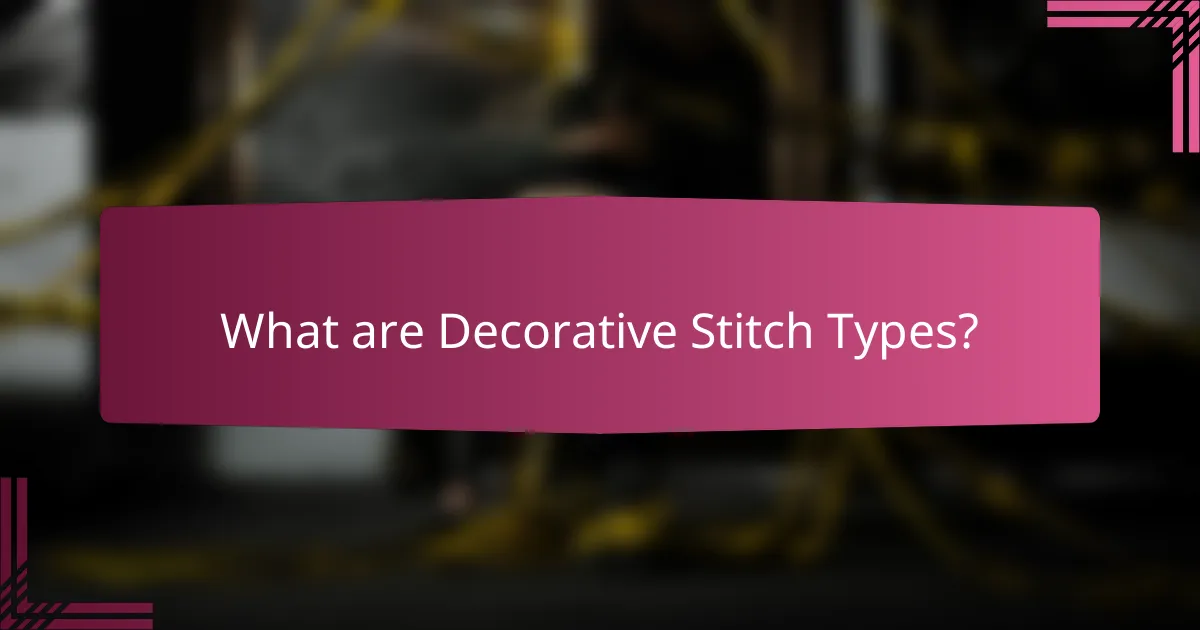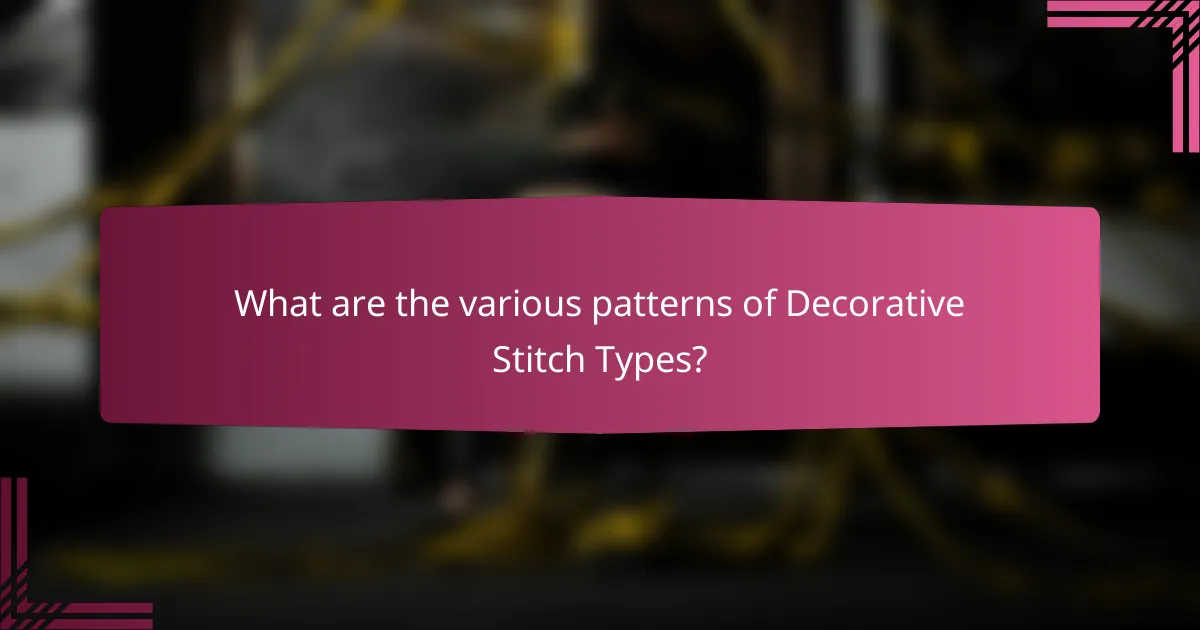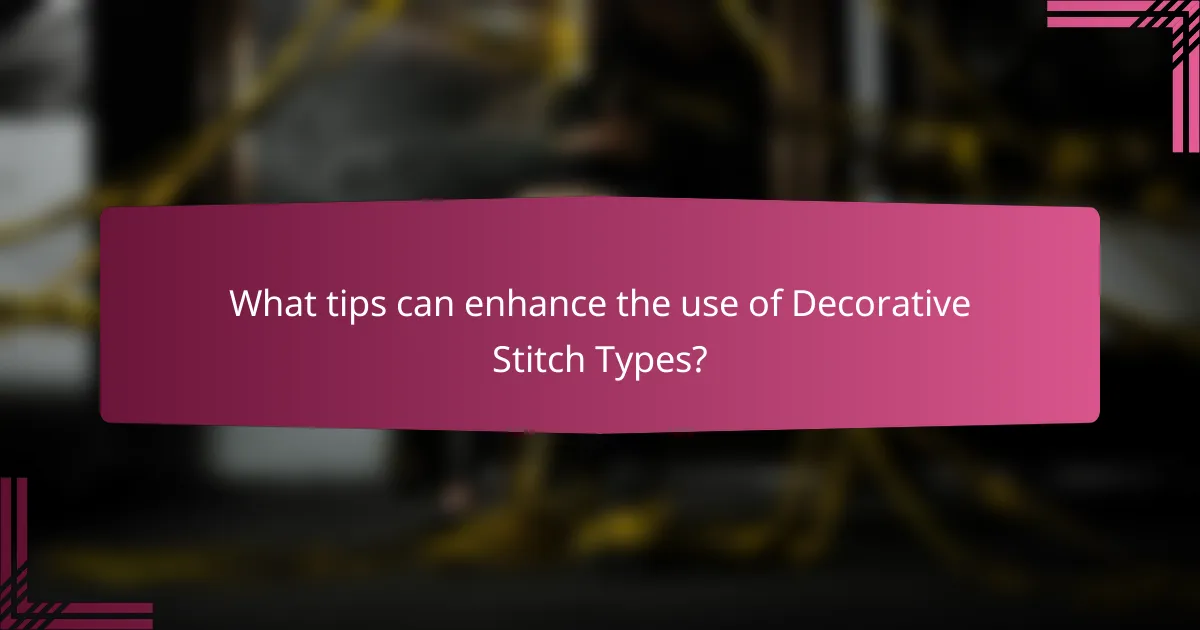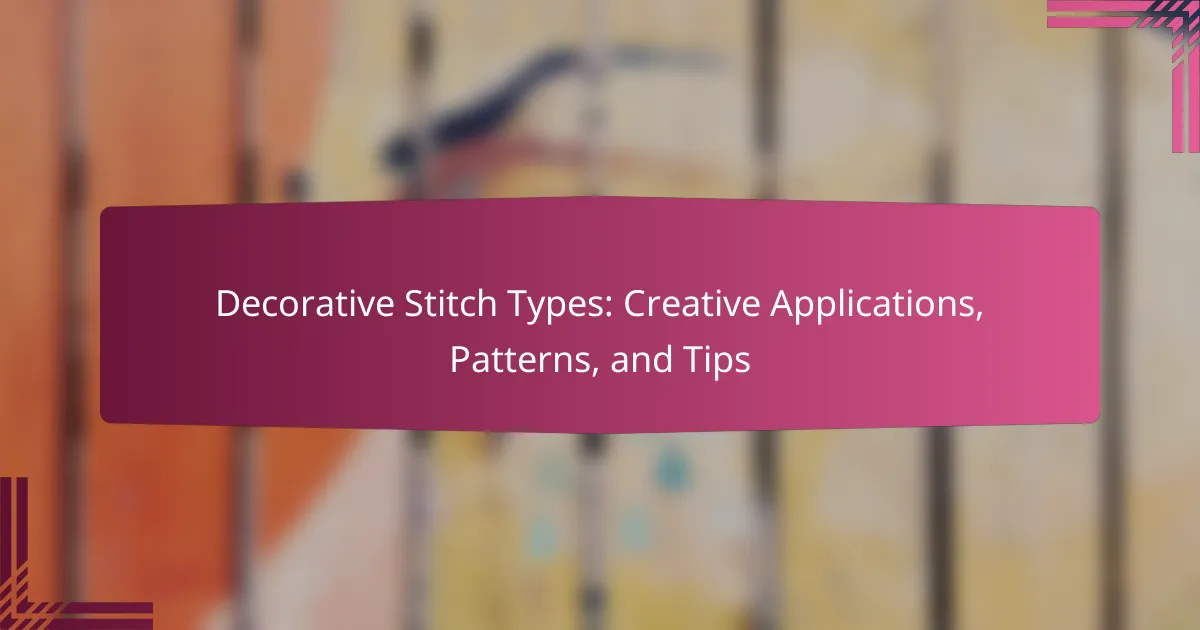
What are Decorative Stitch Types?
Decorative stitch types are specialized sewing techniques used to enhance the visual appeal of fabric. These stitches can create intricate patterns and textures. Common types include satin stitch, zigzag stitch, and blanket stitch. Each stitch serves a unique purpose in design and functionality. Satin stitch provides a smooth, shiny finish. Zigzag stitch offers flexibility and stretch, ideal for knit fabrics. Blanket stitch is often used to finish edges and prevent fraying. Decorative stitches are widely used in quilting, embroidery, and garment construction. They add artistic flair and personalization to sewing projects.
How do Decorative Stitch Types differ from regular stitches?
Decorative stitch types differ from regular stitches in their design and function. Regular stitches primarily serve to join fabric pieces together securely. They focus on strength and durability. In contrast, decorative stitches emphasize aesthetic appeal. They create patterns and embellishments on the fabric surface. Decorative stitches often feature unique shapes and intricate designs. Examples include satin stitches, zigzag stitches, and heirloom stitches. These stitches enhance the visual interest of a project. Regular stitches do not typically provide this level of decoration. Thus, the main distinction lies in the purpose: functionality versus artistry.
What are the essential characteristics of Decorative Stitch Types?
Decorative stitch types are characterized by their aesthetic appeal and functional versatility. They enhance the visual interest of fabric and can serve both decorative and structural purposes. Common characteristics include varied stitch lengths and widths, which create unique patterns. Decorative stitches often feature intricate designs, such as scallops, waves, and florals. They can be executed using various sewing machines or by hand, allowing for flexibility in application. The thread used in decorative stitches may differ in thickness and texture, contributing to the overall effect. Additionally, these stitches can be applied to different fabric types, making them suitable for diverse projects.
Why are Decorative Stitch Types important in sewing and crafting?
Decorative stitch types are important in sewing and crafting because they enhance the aesthetic appeal of projects. These stitches allow for creative expression and personalization in textiles. They can transform plain fabric into visually interesting designs. Decorative stitches also provide functional benefits, such as reinforcing seams. Specific stitch types can add texture and dimension to finished items. Additionally, they can be used to highlight patterns or motifs. The use of decorative stitches is prevalent in quilting, embroidery, and garment making. Their significance is evident in the way they elevate the overall quality of handcrafted items.
What are the common applications of Decorative Stitch Types?
Decorative stitch types are commonly applied in various textile and craft projects. They enhance the visual appeal of garments, home decor, and accessories. For instance, these stitches are used in quilting to create intricate patterns. They also serve to embellish hems and seams in clothing. Additionally, decorative stitches can be utilized in embroidery projects for artistic designs. In crafting, they are often applied to personalize items like bags and pillows. The versatility of decorative stitch types allows for creative expression in sewing and fabric arts.
How can Decorative Stitch Types enhance home décor projects?
Decorative stitch types enhance home décor projects by adding visual interest and texture. These stitches can transform simple fabrics into unique design elements. For example, embroidery stitches can create intricate patterns that elevate the aesthetic of cushions or curtains. Using decorative stitches can also personalize items, making them one-of-a-kind. Stitches like satin, chain, or zigzag can serve both functional and decorative purposes. According to a study by Craft Industry Alliance, 75% of crafters reported increased satisfaction in their projects when incorporating decorative elements. This demonstrates the impact of decorative stitches on the overall appeal of home décor.
What role do Decorative Stitch Types play in garment design?
Decorative stitch types enhance the aesthetic appeal of garment design. They add visual interest and texture to fabrics. These stitches can define style elements such as elegance or casualness. Specific stitch types, like embroidery or pintucks, create unique patterns. They can also serve functional purposes, like reinforcing seams. The use of decorative stitching can elevate a simple garment into a fashion statement. Designers often use these stitches to convey brand identity. This approach helps garments stand out in a competitive market.

What are the various patterns of Decorative Stitch Types?
Various patterns of decorative stitch types include straight stitches, zigzag stitches, and satin stitches. Straight stitches serve as the foundation for many designs. Zigzag stitches create a flexible and decorative edge. Satin stitches provide a smooth, glossy finish on fabric. Other patterns include decorative embroidery stitches like chain stitches and cross stitches. Each stitch type offers unique visual effects. These patterns enhance the aesthetic appeal of textiles. They are widely used in quilting, garment making, and home decor.
What are the most popular Decorative Stitch Patterns?
The most popular decorative stitch patterns include satin stitch, zigzag stitch, and chain stitch. Satin stitch is known for its smooth, glossy finish. It is often used for filling shapes and creating intricate designs. Zigzag stitch creates a textured, wavy line. This stitch is versatile and commonly used for hems and decorative edges. Chain stitch forms a series of loops, resembling a chain. It is popular for outlining and adding dimension to embroidery. Other notable patterns include blanket stitch and cross-stitch. Blanket stitch is useful for finishing edges, while cross-stitch is favored for its grid-like appearance. These patterns are widely used in various sewing and embroidery projects.
How do you create a basic decorative stitch pattern?
To create a basic decorative stitch pattern, start by selecting a fabric and thread. Choose a needle appropriate for the thread thickness. Mark your design lightly on the fabric with a fabric pencil. Begin stitching following the marked lines. Use simple stitches like straight, zigzag, or backstitch for the pattern. Adjust the tension on your sewing machine for consistent results. Practice on scrap fabric before finalizing your design. This method allows for creativity and personalization in stitch patterns.
What are some advanced techniques for unique stitch patterns?
Advanced techniques for unique stitch patterns include using colorwork, layering stitches, and incorporating texture. Colorwork techniques, such as Fair Isle and intarsia, allow for intricate designs by combining different yarn colors. Layering stitches involves stacking multiple stitch types to create depth and dimension in the fabric. Incorporating texture can be achieved through techniques like bobbles, cables, or lace, which add visual interest. These methods enhance the overall design and functionality of the fabric. They are widely used in advanced knitting and crochet projects to achieve distinctive results.
What factors influence the choice of Decorative Stitch Patterns?
The choice of decorative stitch patterns is influenced by several factors. These include the fabric type, which determines the stitch’s compatibility and appearance. The intended use of the project also plays a crucial role; for example, some patterns are better suited for garments while others are ideal for home decor. The skill level of the stitcher influences the complexity of the chosen pattern. Additionally, personal aesthetic preferences guide the selection process, as individuals often seek patterns that reflect their style. Finally, the availability of tools and materials can limit or expand the options for decorative stitches.
How does fabric type affect the selection of stitch patterns?
Fabric type significantly influences the selection of stitch patterns. Different fabrics have varying weights, textures, and stretch properties. Heavier fabrics, like denim, require more robust stitch patterns for durability. Lightweight fabrics, such as silk, benefit from delicate, finer stitches to maintain their drape. Stretchy materials, like knits, necessitate stitch patterns that allow for flexibility, such as zigzag stitches. Additionally, the fabric’s weave can affect how stitches appear; for example, a loose weave may require more secure stitching to prevent fraying. Understanding these characteristics ensures the chosen stitch patterns complement the fabric effectively.
What design elements should be considered when choosing patterns?
When choosing patterns, consider color, scale, and texture. Color affects mood and visual appeal. Scale determines how the pattern interacts with the surrounding space. Texture adds depth and tactile interest. Contrast plays a role in making patterns stand out. Harmony ensures patterns blend well with other design elements. Repetition creates unity and consistency in design. These elements collectively influence the overall effectiveness of the pattern in the intended application.

What tips can enhance the use of Decorative Stitch Types?
To enhance the use of decorative stitch types, consider the following tips. First, select the appropriate thread. High-quality thread can improve stitch definition and appearance. Next, experiment with different fabrics. Various materials can showcase stitches differently. Adjust the tension settings on your sewing machine for optimal results. This can prevent puckering and ensure even stitching. Use stabilizers when working with delicate fabrics. Stabilizers help maintain the fabric’s integrity during stitching. Additionally, practice on scrap fabric before applying stitches to your final project. This allows you to perfect your technique. Lastly, explore different stitch patterns and combinations for unique designs. This creativity can elevate the overall look of your work.
How can beginners effectively use Decorative Stitch Types?
Beginners can effectively use decorative stitch types by starting with basic stitches. They should familiarize themselves with their sewing machine’s capabilities. Practicing on scrap fabric helps build confidence. Beginners can follow online tutorials to learn various techniques. Experimenting with different thread colors enhances visual appeal. Using templates can guide stitch placement for consistent patterns. Incorporating decorative stitches in simple projects, like pillowcases or bags, allows for practical application. Lastly, reviewing completed projects helps identify areas for improvement.
What tools are essential for working with Decorative Stitch Types?
Essential tools for working with decorative stitch types include a sewing machine, specialty presser feet, and embroidery hoops. A sewing machine allows for various stitch patterns and speeds. Specialty presser feet, such as walking feet and free-motion feet, enable different decorative techniques. Embroidery hoops stabilize fabric while stitching intricate designs. Additionally, scissors for trimming threads and fabric, and marking tools for layout are important. These tools collectively enhance the quality and creativity of decorative stitching projects.
How can practice improve proficiency in Decorative Stitch Types?
Practice enhances proficiency in Decorative Stitch Types by fostering skill development and muscle memory. Repeatedly executing various stitches allows for better control over the sewing machine or hand needle. This control leads to more precise and consistent stitch formation. Additionally, regular practice helps in identifying and correcting common mistakes. Over time, practitioners can explore more complex stitch patterns with increased confidence. Studies show that consistent practice can lead to a significant improvement in crafting skills. For instance, a 2018 study published in the Journal of Textile Science found that skilled practitioners improved their stitch accuracy by 30% after dedicated practice sessions.
What common mistakes should be avoided with Decorative Stitch Types?
Common mistakes to avoid with decorative stitch types include incorrect tension settings. Improper tension can lead to puckering or loose stitches. Another mistake is using inappropriate thread types. Choosing the wrong thread can affect the stitch quality. Additionally, neglecting to test stitches on scrap fabric is a frequent oversight. Testing helps to ensure the desired outcome before applying stitches to the final project. Failing to adjust stitch length and width can also result in undesirable effects. Each decorative stitch has optimal settings for best results. Lastly, not following the pattern instructions can lead to mistakes in design execution. Adhering to guidelines ensures accurate replication of intended designs.
How can you troubleshoot issues when using Decorative Stitch Types?
To troubleshoot issues when using decorative stitch types, first check the machine settings. Ensure that the stitch type selected matches the desired decorative stitch. Verify that the thread tension is correctly adjusted; improper tension can lead to uneven stitching. Inspect the needle to confirm it is appropriate for the fabric and stitch type. A dull or incorrect needle can cause skipped stitches or fabric damage. Additionally, examine the fabric for any puckering or distortion. This may indicate that the fabric is not suitable for the chosen stitch type. Finally, refer to the sewing machine manual for specific troubleshooting steps related to decorative stitches. These steps provide a structured approach to resolving common issues encountered with decorative stitch types.
What best practices ensure the best results with Decorative Stitch Types?
To achieve the best results with decorative stitch types, it is essential to select the appropriate thread and needle. Using high-quality thread prevents fraying and ensures a smooth finish. Choosing the right needle size for the fabric type enhances stitch quality. Additionally, adjusting the tension settings on the sewing machine is crucial for consistent results. Testing stitches on scrap fabric allows for adjustments before the final project. Maintaining a steady speed while sewing contributes to even stitching. Lastly, utilizing stabilizers can support intricate designs, preventing distortion during stitching. These practices collectively enhance the overall appearance and durability of decorative stitches.
Decorative stitch types are specialized sewing techniques that enhance the visual appeal of fabric through intricate patterns and textures. This article explores the various types of decorative stitches, such as satin, zigzag, and blanket stitches, highlighting their unique attributes and applications in quilting, embroidery, and garment construction. It also discusses the differences between decorative and regular stitches, essential characteristics, popular patterns, and tips for effective use. Additionally, it covers factors influencing stitch pattern selection, common mistakes to avoid, and best practices to achieve optimal results in sewing projects.
